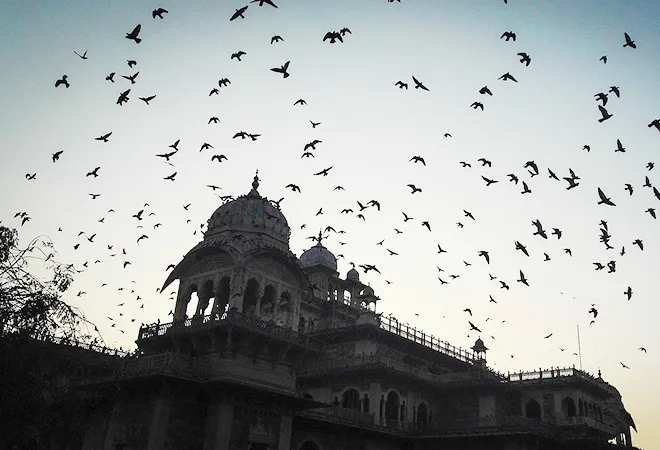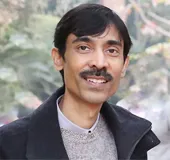
This article is part of the series — India and the World in 2021.
Seven of every 10 Indians live in settlements designated as ‘rural.’ However, a growing number of these settlements are exhibiting characteristics that are no longer considered ‘rural,’ but are emerging as ‘urban.’ For instance, urbanisable areas in various large cities are being extended by town planning departments and development authorities to accommodate the influx of additional populations. The spatial expansion and penetration of urban development in rural hinterlands is leading to reduced farm lands and changing occupational patterns of villagers, seen in a shift to non-agricultural work. Furthermore, with increasing population densities and changing employment patterns, many rural settlements situated near cities are meeting the ‘urban area’ criteria adopted by India’s census office, and are therefore being classified as ‘urban.’ Another phenomenon adding to India’s urbanisation process is the saturation of large cities, and accumulation of population and economic activities in Tier II cities, which are becoming the new growth centres.
Population census data revealed a notable demographic tilt in favour of urban, for the first time, in 2011. During the decade 2001-11, the growth of India’s urban population was slightly higher than that of the rural. The National Commission on Population (NCP) in India predicts that in the next 15 years (i.e., by 2036), about 38.6 percent of Indians (600 million) will live in urban areas. The UN, too, highlights that India’s urban population size will nearly double between 2018 and 2050, from 461 to 877 million. Thus, prevailing trends and future projections indicate that India is steadily moving along the path of urbanisation. At present, the share of India’s urban population in total population is much less than that in other nations like Japan, Brazil, the US, Russia, Indonesia, and China. The story is different, however, in absolute numbers: only China has an absolute urban population larger than India. A large population implies high demand for goods and services, and requirement of efficient systems for urban planning, management and governance.
The spatial expansion and penetration of urban development in rural hinterlands is leading to reduced farm lands and changing occupational patterns of villagers, seen in a shift to non-agricultural work.
Globally, there is consensus over the promotion of urbanisation. Most national governments, including India, consider urbanisation as an important component of their development agenda. This is in recognition of the undeniable benefits that urbanisation can bring to nations and societies. When people with different skills, ideologies, social and cultural backgrounds get together and engage in productive activities and dialogues, a creative environment is formed, and the outputs can be extraordinarily helpful. Such a vibrant environment, which, in theory at least, offers immense possibilities as well as opportunities to all — is witnessed in many of the world’s cities today. Communities, regardless of their educational attainments, skills, or income levels, are benefiting in a variety of ways. Indeed, urbanisation has significantly aided national growth and pulled vast sections of societies from extreme poverty.
These facts, in support of urbanisation, in no way imply that nations should be one hundred-percent urbanised. There are large populations of people who prefer to stay away from the kind of life offered by cities. Furthermore, there is increasing realisation amongst urban policymakers, planners and development agencies, about preservation as well as promotion of culture and traditional practices in rural areas situated within urban jurisdictions. In India, there is evidence of supportive actions taken by the administration in this regard.
When people with different skills, ideologies, social and cultural backgrounds get together and engage in productive activities and dialogues, a creative environment is formed, and the outputs can be extraordinarily helpful.
To be sure, there is an unwanted concomitant to urbanisation: when the government fails to properly exploit the opportunities or manage the phenomenon, it is not only that the full advantages are not derived — there are losses and wastages. Thus, while people may be engaged in various income-generating activities, or pursuing creative and recreational interests, they would still be leading a poor quality of life. For this reason, tremendous work is underway across the world on managing the dynamic conditions prevailing in cities, and addressing various challenging aspects of urban life. This is not an easy task for nations, whether developed or developing, and some are performing better than others. In more developed economies, racial and other social problems are prevalent in urban agglomerations, as are high consumption patterns and huge wastages. In the less developed parts of the world, poverty and people’s access to basic needs are the most crucial issues.
Examples from different parts of the world help build further understanding of the impacts of city-level initiatives. Berlin and Singapore offer efficient multi-modal public transportation systems to connect various parts of the city. In the Chinese cities of Beijing, Haikou, and Shanghai, and in Oslo and London, the rich cultures and traditions are well-maintained. In Europe, countries are learning from previous mistakes and reducing the number of motorised vehicles that ply their urban roads. Durban roads display minimal congestion; people prefer to walk to neighbouring areas. The city government of Moscow uses digital technologies for efficient functioning of transport and health sectors. Abu Dhabi displays excellence in urban planning and development. And Japanese cities are trying to cut down on greenhouse gas emissions and noise pollution.
While people may be engaged in various income-generating activities, or pursuing creative and recreational interests, they would still be leading a poor quality of life.
Indian cities, too, are grappling with the challenges of urbanisation. While the numerous policies, programmes, and reform measures are helping address various dimensions, many problems remain. As the country enters the year 2021, there is immense work at hand.
Foremost is for state governments to recognise that urbanisation is occurring in their jurisdictions. As rural settlements are transforming, they begin to display characteristics similar to those witnessed in urban areas. Ideally, such settlements should be granted an urban status, and thereby be governed by municipal governments that are better equipped to deal with urbanisation-related problems. However, state governments are known to be reluctant in converting such villages to towns, as application of urban regulations in their village — including building by-laws and development controls, as well as taxation — will not go well with village communities and cost them political popularity. This mindset has led to the underestimation of urbanisation in India, as well as uncontrolled and haphazard growth of built structures, shrinking open spaces, indiscriminate land use conversion, and deteriorating quality of life in census towns and rural settlements near cities.
In most cities and smaller urban centres, the old areas are in dire need of attention.
An equally important requirement is to improve the conditions in old areas of urban settlements, as well as in peri-urban areas, small and medium towns. In most cities and smaller urban centres, the old areas are in dire need of attention. While these centres have a vibrant economy, the built structures, infrastructure and services — roads, street lights, footpaths, open spaces, drainage, sewerage and sanitary systems — are in an abysmal state. During the monsoon season, for example, there are frequent incidents of buildings that collapse due to their dilapidated condition — unacknowledged and unaddressed for long. While the inhabitants find little choice but to adjust to these sub-human conditions, the civic administration must initiate required reform measures and engage with communities to improve the deplorable conditions.
A third concern pertains to the capabilities of civic agencies in the areas of management, financing, and master plan formulation and implementation. The latter, in particular, is key. After all, their performance in the preparation of master plans and in discharge of duties, or the quality of governance, determines the state of affairs in urban centres. Inadequate performance has resulted in the emergence of numerous problems. While the agencies are interested in performing better, they are unable to do so due to their weak managerial and financial condition, and the inadequate support received from higher levels of government. In the case of many urban centres, it is noted that master plans (or development plans) have not been prepared, and there is a huge shortage of trained urban planners and development experts. The previous reform measures for empowerment of municipalities through Constitution (Seventy-fourth) Amendment Act, 1992, and training of municipal functionaries, have had a limited impact.
The prevailing conditions call for applying a new set of urban reform strategies that can help build resilience.
In 2020, the most crucial problems witnessed in India’s urban sector were the growing informality — in the form of slums and unorganised economic activities — along with violations of development norms, deterioration of air and water quality, depletion of natural resources, traffic and transportation inadequacies, mismanagement of solid and liquid waste, erratic electricity supply, waterlogging, loss of heritage and culture, lack of rural-urban integration, growing intolerance, and violence and crime. The outbreak of the COVID-19 pandemic has only magnified these challenges; the prevailing conditions call for applying a new set of urban reform strategies that can help build resilience.
In 2021, India’s imperatives include uplifting the lives of marginalised populations, creating mechanisms for people’s participation in civic affairs, and controlling population growth. The ongoing national and state-level initiatives, including Atal Mission for Rejuvenation and Urban Transformation (AMRUT), Housing for All, Smart Cities, Swachh Bharat and Rurban Missions, offer an opportunity to better manage India’s urban transition. The governments at the national, state, and local levels must make greater efforts to ensure that the benefits of urbanisation reach all sections of society.
The views expressed above belong to the author(s). ORF research and analyses now available on Telegram! Click here to access our curated content — blogs, longforms and interviews.




 PREV
PREV


